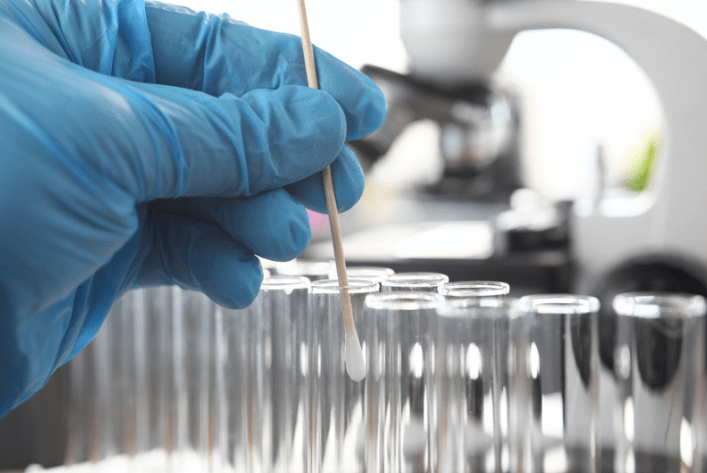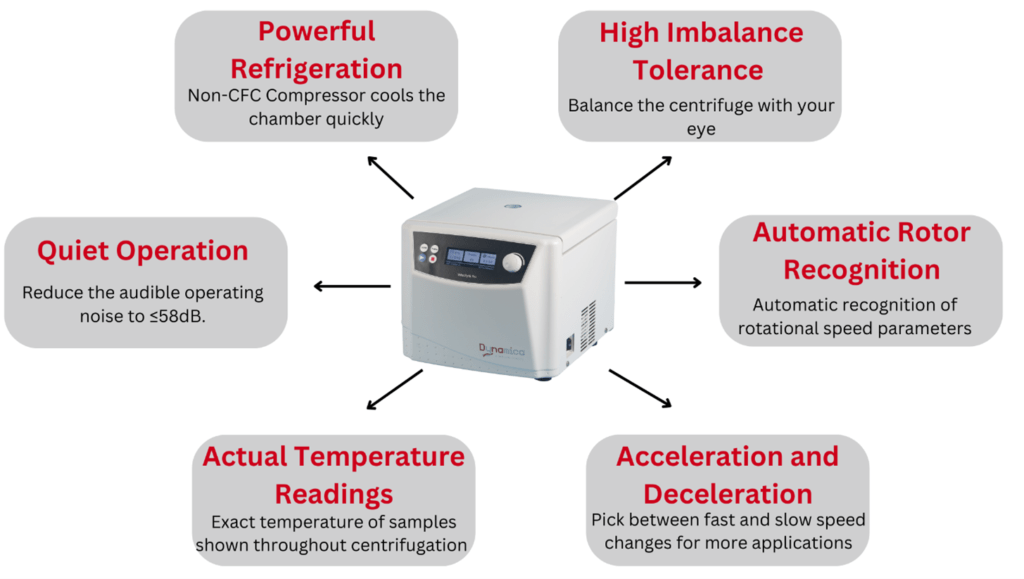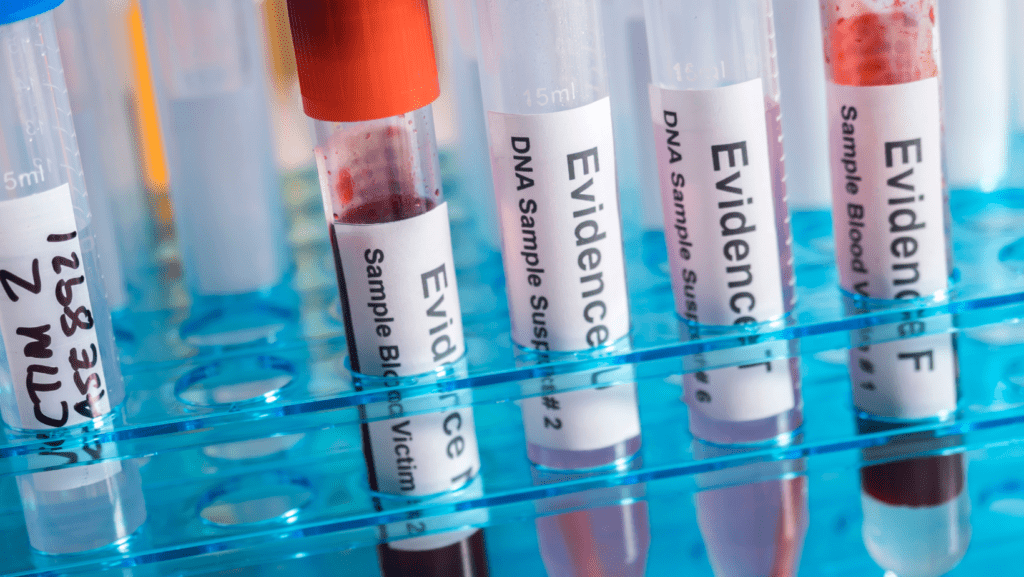Dynamica centrifuges are designed for versatility and flexibility to maximise performance efficiency in the multifaceted laboratory environment. Simplify your separation needs with Techcomp Lab products Dynamica centrifuge solutions.
Key Points
-
- Centrifuges are versatile instruments used for multiple applications, with DNA extraction being a common use
-
- Fast, accurate and reliable DNA extraction is vital for applications such as forensics and diagnostics
-
- Dynamica’s Velocity 15R Pro Microcentrifuge is the ideal product for DNA extraction with key features such as powerful refrigeration and high imbalance tolerance to streamline your laboratory processes.

Introduction
Centrifuges are found in a wide variety of laboratories and are required by many applications from whole blood separation to DNA extraction. Many laboratories contain several centrifuges of different sizes and speeds to ensure all of their application needs are met. Here at Dynamica, we have developed a range of centrifuges to offer comprehensive solutions to the user.
Each centrifuge is complimented by a wide range of rotors, meaning that a variety of different tube sizes can be used in one centrifuge. Simplify your workflow with Dynamica centrifuges, so you can focus on what matters most – your research.
A key product in our range is the Velocity 15R Pro microcentrifuge. This versatile product will make your head (and your samples) spin with multiple rotor options, a high imbalance tolerance, and a powerful refrigeration system. In this blog, we will detail how the Velocity 15R Pro Microcentrifuge is the ideal product to use in your DNA extraction process.
DNA Extraction and Dynamica Microcentrifuge
DNA extraction is widely used in research in a variety of different fields, such as molecular biology and immunology. It involves isolating DNA from cells or viruses and purifying the DNA so it is free from other cellular components. This process is commonly used within forensics, where DNA is isolated from biological samples collected from a crime scene. This information can then be used to create a DNA profile which can be used in a criminal investigation. Other applications of DNA extraction include diagnosing diseases and genetic disorders.

Diagnosing Genetic Disorders
Different types of genetic disorders can occur depending on how the DNA is affected. An example of this includes single nucleotide polymorphisms (SNPs) and deletion/insertion polymorphisms (DIPs). SNPs means that there are changes to one nucleotide in the DNA sequence (A, T, G or C), and DIPs means that nucleotides are either inserted or deleted within the DNA sequence. Different disorders occur depending on the frequency and locations of SNPs and DIPs, such as cystic fibrosis, sickle-cell anaemia and Huntington’s disease.
Being able to identify which diseases an individual suffers from is vital to ensure that appropriate treatment is given. Therefore detecting SNPs and DIPs are a crucial step, and is conducted through PCR sequencing or genotyping. All of these methods involve the extracting and amplifying of DNA, and then comparing the genetic sequence to a reference standard in order to identify any anomalies.
Dynamica Velocity 15R Pro Microcentrifuge and DNA Extraction
Accurate and efficient DNA extraction is vital for the applications mentions, and an essential step in this process is ensuring a reliable centrifuge is utilised in the DNA precipitation stage. This step involves utilising alcohol to aggregate the DNA, and form a pellet at the bottom of the tube, the DNA can then be separated from the remainder of the solution using a microcentrifuge. The centrifuge parameters for this step are normally as follows:
-
- Speed: 12,000 rpm
-
- Time: 10 minutes
-
- Temperature: 4oC
The temperature is set at 4oC as a lower temperature improves the quality of DNA precipitation, preventing the degradation of DNA, and resulting in a pellet of DNA forming more easily due to the decreased solubility of DNA in ethanol.
Therefore, utilising a microcentrifuge which is able to maintain this temperature and provide an accurate and reliable temperature reading is essential. The Dynamica Velocity 15R Pro microcentrifuge is the ideal choice for this application, due to the powerful refrigeration and actual sample temperature measurement and display.
Key Features of the Velocity 15R Pro Microcentrifuge for DNA Extraction
You deserve laboratory equipment that you can rely on to ensure that your processes continually run smoothly and efficiently. Utilising Dynamica’s extensive experience in product design, we have designed centrifuges with the customer in mind, and developed key features to produce a dynamic centrifuge that can adapt to different applications.

-
- Three volumes in one compact design. This means that different sizes of tubes can fit into the centrifuge without having to change the rotor. Minimising the amount of times the rotor requires changing for tube sizes means that the user will save both space and time, allowing you to perform different applications, with different tubes, all with one centrifuge and one rotor.
-
- High imbalance tolerance. A flexible draft shaft allows for greater imbalance tolerances, meaning that you can balance the centrifuge with your eye, rather than the tedious task of weighing out tubes to balance the centrifuge.
-
- Accurate temperature readings and powerful refrigeration. Our centrifuge chamber is cooled rapidly and maintains the rotor (and the samples) at the desired temperature throughout the centrifugation cycle. This allows for the efficient completion of all temperature-sensitive experiments. Actual temperature reading of samples is displayed, allowing for precise, reproducible and efficient experimentation. The non-CFC compressor cools the chamber and the samples, which also extends the motor lifespan as it prevents overheating.
-
- Acceleration and Deceleration: the ability to choose between fast and slow speed changes increases the application spectrum of the centrifuge. For example, you can conduct density gradient centrifugation, where the solvent is separated into different layers dependent on the density of the sample. To ensure this separation, it’s important to have a slow deceleration so the gradient layers are not disturbed.
To find out more about how the Velocity 15R Pro Microcentrifuge can be used in your lab, for DNA extraction or any other application, you can contact our team who will be happy to help you.



